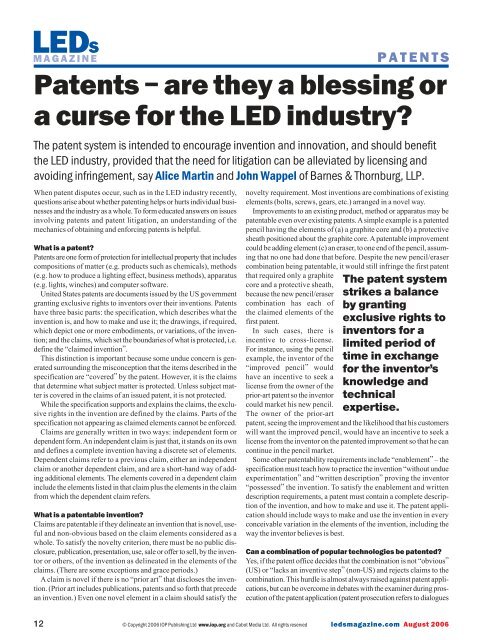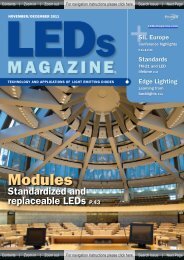LEDs Magazine Review - Beriled
LEDs Magazine Review - Beriled
LEDs Magazine Review - Beriled
- No tags were found...
Create successful ePaper yourself
Turn your PDF publications into a flip-book with our unique Google optimized e-Paper software.
LEDSMAGAZINEPATENTSPatents – are they a blessing ora curse for the LED industry?The patent system is intended to encourage invention and innovation, and should benefitthe LED industry, provided that the need for litigation can be alleviated by licensing andavoiding infringement, say Alice Martin and John Wappel of Barnes & Thornburg, LLP.When patent disputes occur, such as in the LED industry recently,questions arise about whether patenting helps or hurts individual businessesand the industry as a whole. To form educated answers on issuesinvolving patents and patent litigation, an understanding of themechanics of obtaining and enforcing patents is helpful.What is a patent?Patents are one form of protection for intellectual property that includescompositions of matter (e.g. products such as chemicals), methods(e.g. how to produce a lighting effect, business methods), apparatus(e.g. lights, winches) and computer software.United States patents are documents issued by the US governmentgranting exclusive rights to inventors over their inventions. Patentshave three basic parts: the specification, which describes what theinvention is, and how to make and use it; the drawings, if required,which depict one or more embodiments, or variations, of the invention;and the claims, which set the boundaries of what is protected, i.e.define the “claimed invention”.This distinction is important because some undue concern is generatedsurrounding the misconception that the items described in thespecification are “covered” by the patent. However, it is the claimsthat determine what subject matter is protected. Unless subject matteris covered in the claims of an issued patent, it is not protected.While the specification supports and explains the claims, the exclusiverights in the invention are defined by the claims. Parts of thespecification not appearing as claimed elements cannot be enforced.Claims are generally written in two ways: independent form ordependent form. An independent claim is just that, it stands on its ownand defines a complete invention having a discrete set of elements.Dependent claims refer to a previous claim, either an independentclaim or another dependent claim, and are a short-hand way of addingadditional elements. The elements covered in a dependent claiminclude the elements listed in that claim plus the elements in the claimfrom which the dependent claim refers.What is a patentable invention?Claims are patentable if they delineate an invention that is novel, usefuland non-obvious based on the claim elements considered as awhole. To satisfy the novelty criterion, there must be no public disclosure,publication, presentation, use, sale or offer to sell, by the inventoror others, of the invention as delineated in the elements of theclaims. (There are some exceptions and grace periods.)A claim is novel if there is no “prior art” that discloses the invention.(Prior art includes publications, patents and so forth that precedean invention.) Even one novel element in a claim should satisfy thenovelty requirement. Most inventions are combinations of existingelements (bolts, screws, gears, etc.) arranged in a novel way.Improvements to an existing product, method or apparatus may bepatentable even over existing patents. Asimple example is a patentedpencil having the elements of (a) a graphite core and (b) a protectivesheath positioned about the graphite core. A patentable improvementcould be adding element (c) an eraser, to one end of the pencil, assumingthat no one had done that before. Despite the new pencil/erasercombination being patentable, it would still infringe the first patentthat required only a graphitecore and a protective sheath,because the new pencil/erasercombination has each ofthe claimed elements of thefirst patent.In such cases, there isincentive to cross-license.For instance, using the pencilexample, the inventor of the“improved pencil” wouldhave an incentive to seek alicense from the owner of theprior-art patent so the inventorcould market his new pencil.The owner of the prior-artThe patent systemstrikes a balanceby grantingexclusive rights toinventors for alimited period oftime in exchangefor the inventor’sknowledge andtechnicalexpertise.patent, seeing the improvement and the likelihood that his customerswill want the improved pencil, would have an incentive to seek alicense from the inventor on the patented improvement so that he cancontinue in the pencil market.Some other patentability requirements include “enablement” – thespecification must teach how to practice the invention “without undueexperimentation” and “written description” proving the inventor“possessed” the invention. To satisfy the enablement and writtendescription requirements, a patent must contain a complete descriptionof the invention, and how to make and use it. The patent applicationshould include ways to make and use the invention in everyconceivable variation in the elements of the invention, including theway the inventor believes is best.Can a combination of popular technologies be patented?Yes, if the patent office decides that the combination is not “obvious”(US) or “lacks an inventive step” (non-US) and rejects claims to thecombination. This hurdle is almost always raised against patent applications,but can be overcome in debates with the examiner during prosecutionof the patent application (patent prosecution refers to dialogues12© Copyright 2006 IOP Publishing Ltd www.iop.org and Cabot Media Ltd. All rights reservedledsmagazine.com August 2006
















